Shamrock Foods Bundle
How has Shamrock Foods Company stayed ahead in the food service game?
From its humble beginnings with dairy cows to its current status as a food distribution giant, Shamrock Foods has consistently adapted and thrived. This evolution is a testament to its savvy sales and marketing strategies, which have fueled its impressive growth. Understanding these strategies is key to appreciating how Shamrock Foods has become a major player in the competitive food service industry.
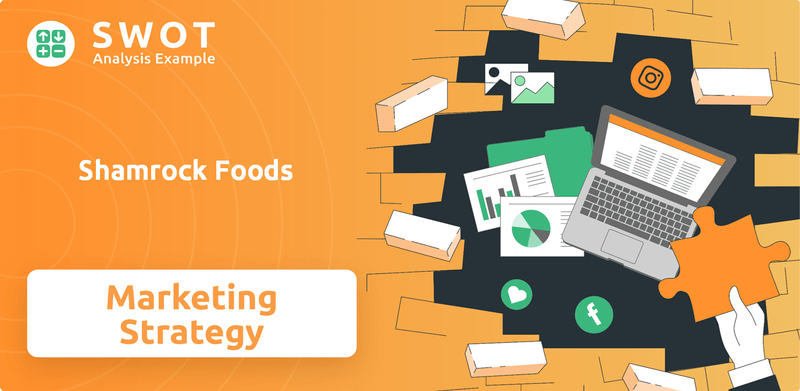
This article will explore the Shamrock Foods SWOT Analysis, examining its sales channels, marketing tactics, and brand positioning. We'll dissect the company's approach to the food distribution landscape, including its digital marketing initiatives, customer relationship management, and how it maintains a strong market share. Learn how Shamrock Foods' strategic decisions, from its product portfolio to its supply chain management, have contributed to its sustained success and competitive advantage within the food service industry.
How Does Shamrock Foods Reach Its Customers?
The sales strategy of Shamrock Foods Company relies on a multifaceted approach to reach its diverse customer base effectively. This food distribution company leverages a combination of direct sales and digital platforms. Their primary sales channels include direct sales teams, which cater to a wide array of customers like restaurants, healthcare facilities, schools, and entertainment venues across the Western United States.
Shamrock Foods' distribution network is a key component of its sales strategy. The company operates through a network of 11 distribution centers, serving over 24,000 customers. This extensive network ensures efficient product delivery and supports the company's commitment to customer service. The company's focus on digital adoption and omnichannel integration is evident in its e-commerce platforms.
The evolution of Shamrock Foods' sales channels has seen a significant strategic shift towards digital adoption and omnichannel integration. The company has invested in e-commerce platforms, notably its 'ShamrockORDERS' online ordering system, which provides 24/7 access to thousands of products, order history, and customizable order guides. This digital transformation aims to streamline the ordering process, reduce delivery times, and improve overall efficiency, with e-commerce sales in the foodservice distribution industry projected to reach $40 billion by 2025.
Direct sales teams are a primary channel, serving a broad customer base including restaurants, healthcare facilities, schools, casinos, entertainment venues, and lodging establishments. These teams focus on building relationships and providing tailored solutions to meet customer needs. This direct approach allows for personalized service and supports customer retention.
Shamrock Foods utilizes a network of 11 distribution centers to serve over 24,000 customers. These centers ensure efficient product delivery and support the company's extensive reach across the Western United States. This robust distribution network is crucial for maintaining supply chain efficiency.
The company has invested in e-commerce platforms, such as 'ShamrockORDERS', to streamline the ordering process. These platforms offer 24/7 access to thousands of products, order history, and customizable order guides. This digital transformation aims to reduce delivery times and improve overall efficiency.
Shamrock Foodservice Warehouse retail locations provide another avenue for reaching customers. These retail locations offer a convenient option for customers to purchase products directly. This channel complements the company's broader distribution strategy.
Shamrock Foods has established key partnerships to strengthen its market presence and distribution capabilities. The company's products are found in over 45,000 quick-service restaurants nationally. Contracts with organizations like Equalis Group for foodservice products for schools and public sector organizations highlight their strategic partnerships for growth.
- Partnerships with national restaurant chains like Village Inn.
- Distribution of dairy products through Shamrock Farms to supermarkets and convenience stores.
- Strategic contracts to expand its reach within the foodservice industry.
- Focus on digital adoption and omnichannel integration.
The company's sales and marketing teams are crucial for driving growth and maintaining customer relationships. The company's marketing strategy also focuses on building brand awareness and customer loyalty. For a deeper understanding of the competitive landscape, you can explore the Competitors Landscape of Shamrock Foods. This approach, combined with strategic partnerships and digital initiatives, positions Shamrock Foods to capitalize on the projected growth in the food service industry.
Shamrock Foods SWOT Analysis
- Complete SWOT Breakdown
- Fully Customizable
- Editable in Excel & Word
- Professional Formatting
- Investor-Ready Format
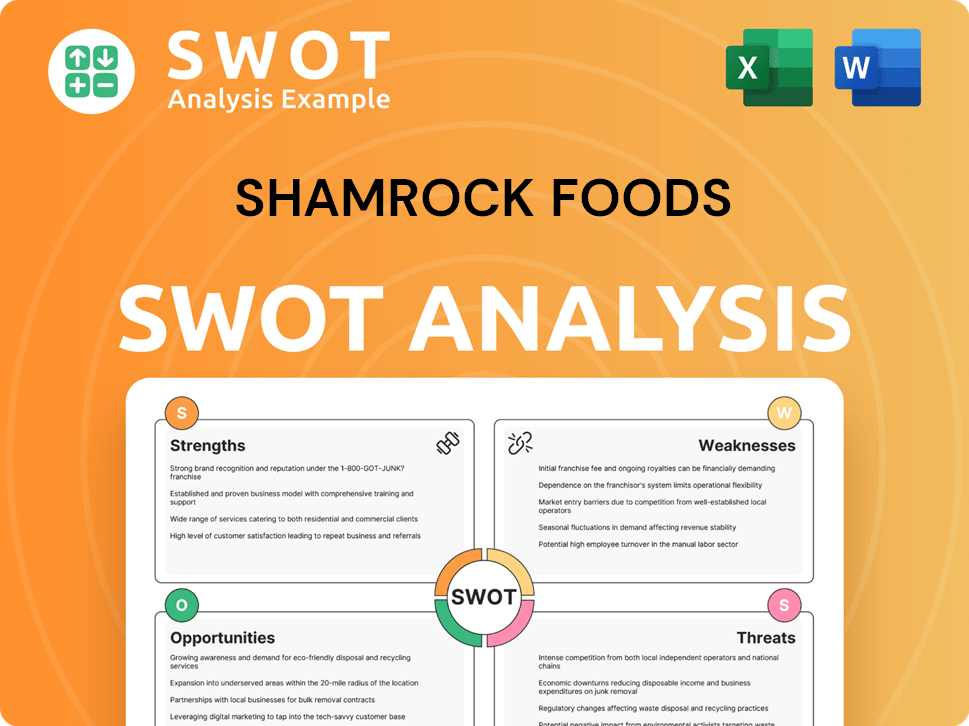
What Marketing Tactics Does Shamrock Foods Use?
The marketing tactics employed by Shamrock Foods are designed to boost brand awareness, generate leads, and drive sales within the food service and dairy sectors. Their approach is a blend of digital and traditional strategies, reflecting current industry trends. The company's commitment to providing value and building relationships is evident in its marketing efforts.
In the digital realm, Shamrock Foods uses content marketing, email marketing, and social media to engage with customers. They also embrace data-driven marketing, utilizing technology platforms for personalization and improved operational efficiency. These strategies are aimed at creating more targeted campaigns and enhancing customer experiences.
Traditional marketing efforts, such as participation in industry events, complement the digital strategies. These events offer direct engagement opportunities and help reinforce brand presence. The company also highlights its commitment to sustainability, aligning with the growing consumer demand for environmentally friendly practices.
Shamrock Foods leverages digital marketing through content marketing via its 'Kitchentelligence' resource, email marketing offering recipes and coupons, and social media for promotions. These digital strategies align with broader 2024 marketing trends emphasizing authenticity and transparency.
The company focuses on data-driven marketing, incorporating personalization and predictive power through technology platforms like Microsoft Azure Cloud Services and Microsoft Dynamics 365. This approach supports targeted strategies and operational efficiency.
'ShamrockORDERS' online platform serves as a marketing tool, providing product recommendations based on buying history and current trends. This enhances customer experience and drives sales through personalized suggestions.
Traditional marketing includes participation in industry events like the Shamrock Foods EXPO, where the company showcases new products and facilitates networking. These events provide direct engagement and reinforce brand presence.
Shamrock Foods highlights its commitment to sustainability in its marketing, aligning with the increasing consumer demand for environmentally friendly practices. This focus helps build brand loyalty and attract customers.
The evolution of Shamrock Foods' marketing mix reflects a shift towards more personalized and engaging experiences, recognizing the importance of building relationships. This customer-centric approach is key in the food service industry.
The company's Owners & Shareholders of Shamrock Foods likely support these marketing strategies. The food service industry is expected to reach $997.7 billion in 2024, according to the National Restaurant Association. Furthermore, digital marketing spending in the food and beverage industry is projected to continue its growth, with a focus on personalization and data analytics. This strategy supports the company's overall sales and marketing goals.
Shamrock Foods employs a mix of digital and traditional marketing tactics to build brand awareness and drive sales. Their approach includes content marketing, email marketing, social media, and data-driven strategies.
- Content Marketing: 'Kitchentelligence' resource provides food trends and business tips.
- Email Marketing: Offers recipes and coupons to subscribers.
- Social Media: Used for promotions and brand visibility.
- Data-Driven Marketing: Leverages technology for targeted strategies.
- Traditional Marketing: Participation in industry events like the Shamrock Foods EXPO.
- Sustainability: Highlights commitment to environmentally friendly practices.
Shamrock Foods PESTLE Analysis
- Covers All 6 PESTLE Categories
- No Research Needed – Save Hours of Work
- Built by Experts, Trusted by Consultants
- Instant Download, Ready to Use
- 100% Editable, Fully Customizable
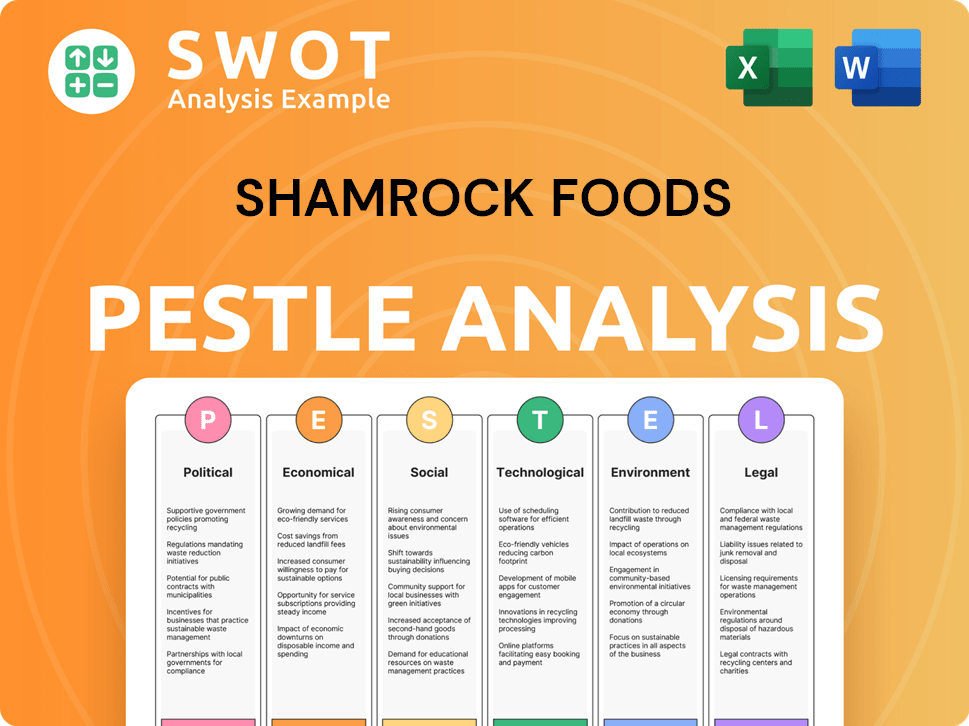
How Is Shamrock Foods Positioned in the Market?
Shamrock Foods positions itself as a trusted leader in food service distribution and dairy manufacturing, built on a foundation of quality, innovation, and customer-centricity. The company emphasizes its long-standing history, tracing back to its founding in 1922, which fosters strong brand recognition and customer trust. This legacy is a key component of their Shamrock Foods brand identity.
The company's diversified business model, encompassing both food service distribution and the nationally recognized dairy brand, enhances its market position and stability. They focus on providing a comprehensive portfolio of high-quality, fresh ingredients and business solutions. This approach, going 'beyond delivery,' is central to their brand promise and Shamrock Foods sales strategy.
Brand consistency is maintained across all touchpoints, from distribution services to retail warehouse stores and dairy products. Furthermore, Shamrock Foods emphasizes sustainability, aligning with growing consumer and industry trends. Initiatives like reducing environmental impact and providing local and organic products reinforce its brand values and appeal to environmentally conscious customers. The company's recognition in 2024-2025 for Global Leadership Institute Awards by HMG Strategy indirectly reflects its strong standing and leadership within the industry.
Shamrock Foods prioritizes customer success by offering comprehensive business solutions and collaboration opportunities. This focus on partnership is a key element of its brand promise. Their Shamrock Foods customer relationship management is designed to build strong, lasting relationships.
The company is committed to providing high-quality, fresh ingredients. This commitment is evident in their extensive product portfolio, including fresh custom-cut meat, seafood, produce, and dairy. This emphasis on quality is a core aspect of their Shamrock Foods product portfolio.
Shamrock Foods actively pursues sustainability through water stewardship, energy conservation, and responsible waste management. They also offer local and organic products, appealing to environmentally conscious consumers. These initiatives support the Shamrock Foods sustainability initiatives.
Brand consistency is maintained across all channels, from distribution services to retail stores and dairy products. This unified approach reinforces their brand identity and ensures a consistent customer experience. This is a key part of their Shamrock Foods brand awareness strategies.
Shamrock Foods' brand positioning is built on several key pillars:
- Family-Owned Legacy: Over 100 years of service, building trust.
- Quality Ingredients: Commitment to fresh, high-quality products.
- Customer-Centricity: Focus on partnership and business solutions.
- Sustainability: Commitment to environmental responsibility.
Shamrock Foods Business Model Canvas
- Complete 9-Block Business Model Canvas
- Effortlessly Communicate Your Business Strategy
- Investor-Ready BMC Format
- 100% Editable and Customizable
- Clear and Structured Layout
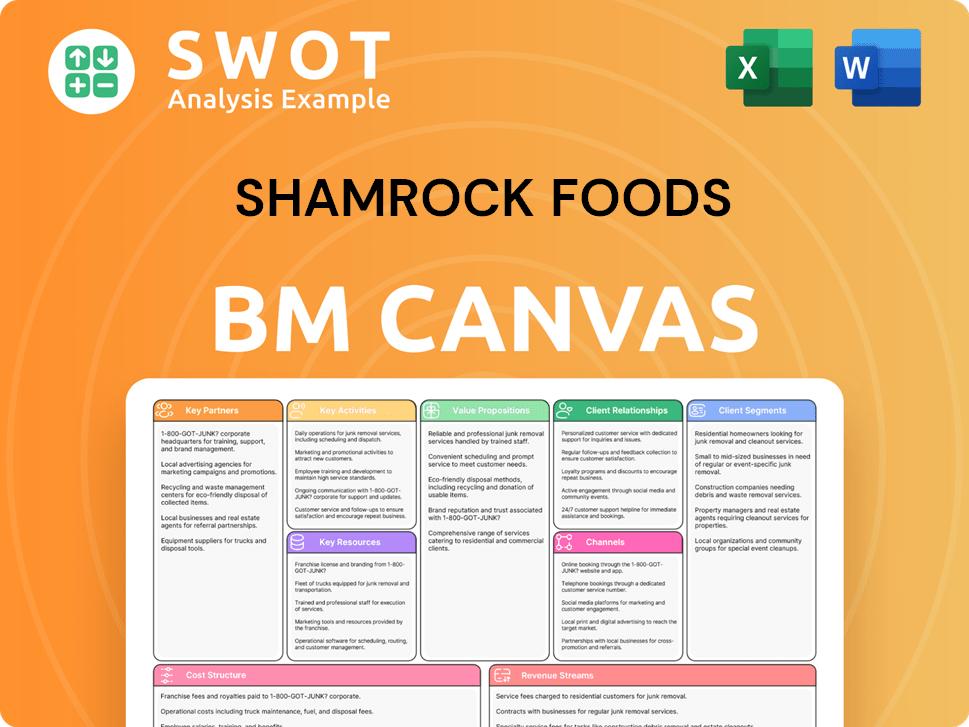
What Are Shamrock Foods’s Most Notable Campaigns?
The Shamrock Foods sales strategy and marketing efforts for 2024-2025 are centered on digital transformation, customer engagement, and product innovation. Key campaigns are designed to boost efficiency, enhance customer experience, and respond to evolving consumer preferences. These initiatives reflect a comprehensive approach to maintain and grow market share in the competitive food distribution and food service industry.
A significant part of the Shamrock Foods marketing strategy involves leveraging digital platforms, particularly the 'ShamrockORDERS' online ordering system. This focus aims to streamline the ordering process, provide 24/7 access, and facilitate e-commerce sales. Concurrently, the company actively participates in industry events, such as the Shamrock Foods EXPO, to engage with customers, showcase new products, and offer promotions.
Furthermore, the company's approach includes ongoing product innovation and sustainability initiatives. These initiatives demonstrate Shamrock Foods' commitment to adapting to consumer demands and industry trends, including a focus on health-conscious options and environmental responsibility. These efforts contribute to building brand awareness and strengthen customer relationships in the food distribution sector.
The 'ShamrockORDERS' platform is a key element of the Shamrock Foods sales strategy. This digital platform offers 24/7 access, detailed product information, and tools for cost control and menu planning. The food service industry is projected to reach $40 billion by 2025, making digital platforms crucial for growth.
Events like the Shamrock Foods EXPO are essential for customer engagement. These events include product showcases, exclusive promotions, and the 'Fired Up! Challenge' to generate excitement and demonstrate product versatility. These events directly enhance customer relationships.
Continuous innovation in product development is a core part of the Shamrock Foods marketing strategy. This includes focusing on health-conscious options, such as higher protein and lower sugar products, to meet changing consumer demands. This is crucial for maintaining a competitive edge.
Shamrock Foods emphasizes sustainability through initiatives aimed at reducing environmental impact and offering local, sustainable products. This aligns with consumer preferences and industry trends, building brand loyalty. This approach is vital for long-term growth.
The Shamrock Foods sales and marketing team focuses on several key strategies to drive growth and maintain a strong market presence. These strategies include digital marketing, customer relationship management, and product portfolio expansion. For a deeper understanding of Shamrock Foods' overall growth strategy, explore the Growth Strategy of Shamrock Foods.
- Digital Marketing Initiatives: Enhanced online presence and e-commerce capabilities to streamline operations.
- Customer Relationship Management: Strengthening relationships through events and personalized services.
- Product Portfolio Expansion: Introducing new products to meet changing consumer needs.
- Sustainability: Emphasizing environmental responsibility.
Shamrock Foods Porter's Five Forces Analysis
- Covers All 5 Competitive Forces in Detail
- Structured for Consultants, Students, and Founders
- 100% Editable in Microsoft Word & Excel
- Instant Digital Download – Use Immediately
- Compatible with Mac & PC – Fully Unlocked
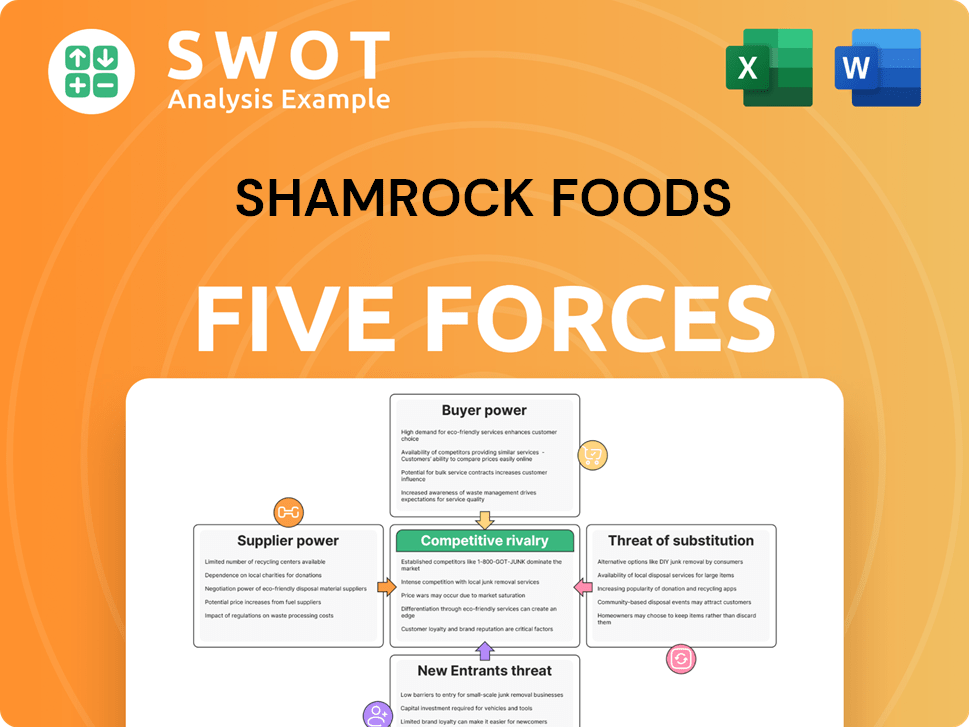
Related Blogs
- What are Mission Vision & Core Values of Shamrock Foods Company?
- What is Competitive Landscape of Shamrock Foods Company?
- What is Growth Strategy and Future Prospects of Shamrock Foods Company?
- How Does Shamrock Foods Company Work?
- What is Brief History of Shamrock Foods Company?
- Who Owns Shamrock Foods Company?
- What is Customer Demographics and Target Market of Shamrock Foods Company?
Disclaimer
All information, articles, and product details provided on this website are for general informational and educational purposes only. We do not claim any ownership over, nor do we intend to infringe upon, any trademarks, copyrights, logos, brand names, or other intellectual property mentioned or depicted on this site. Such intellectual property remains the property of its respective owners, and any references here are made solely for identification or informational purposes, without implying any affiliation, endorsement, or partnership.
We make no representations or warranties, express or implied, regarding the accuracy, completeness, or suitability of any content or products presented. Nothing on this website should be construed as legal, tax, investment, financial, medical, or other professional advice. In addition, no part of this site—including articles or product references—constitutes a solicitation, recommendation, endorsement, advertisement, or offer to buy or sell any securities, franchises, or other financial instruments, particularly in jurisdictions where such activity would be unlawful.
All content is of a general nature and may not address the specific circumstances of any individual or entity. It is not a substitute for professional advice or services. Any actions you take based on the information provided here are strictly at your own risk. You accept full responsibility for any decisions or outcomes arising from your use of this website and agree to release us from any liability in connection with your use of, or reliance upon, the content or products found herein.